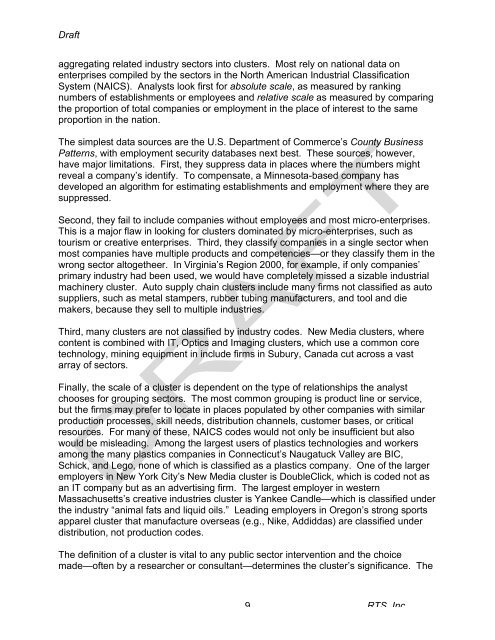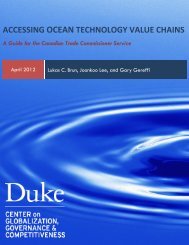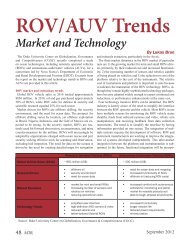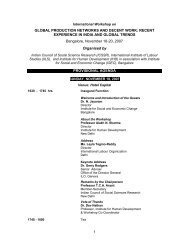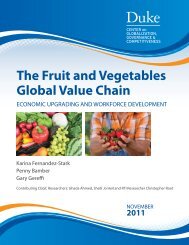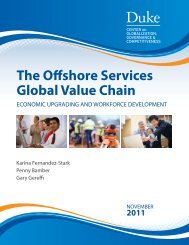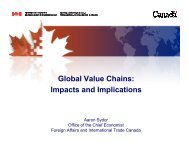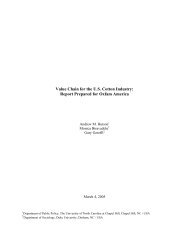Paper - Center on Globalization, Governance & Competitiveness
Paper - Center on Globalization, Governance & Competitiveness
Paper - Center on Globalization, Governance & Competitiveness
You also want an ePaper? Increase the reach of your titles
YUMPU automatically turns print PDFs into web optimized ePapers that Google loves.
Draft<br />
aggregating related industry sectors into clusters. Most rely <strong>on</strong> nati<strong>on</strong>al data <strong>on</strong><br />
enterprises compiled by the sectors in the North American Industrial Classificati<strong>on</strong><br />
System (NAICS). Analysts look first for absolute scale, as measured by ranking<br />
numbers of establishments or employees and relative scale as measured by comparing<br />
the proporti<strong>on</strong> of total companies or employment in the place of interest to the same<br />
proporti<strong>on</strong> in the nati<strong>on</strong>.<br />
The simplest data sources are the U.S. Department of Commerce’s County Business<br />
Patterns, with employment security databases next best. These sources, however,<br />
have major limitati<strong>on</strong>s. First, they suppress data in places where the numbers might<br />
reveal a company’s identify. To compensate, a Minnesota-based company has<br />
developed an algorithm for estimating establishments and employment where they are<br />
suppressed.<br />
Sec<strong>on</strong>d, they fail to include companies without employees and most micro-enterprises.<br />
This is a major flaw in looking for clusters dominated by micro-enterprises, such as<br />
tourism or creative enterprises. Third, they classify companies in a single sector when<br />
most companies have multiple products and competencies—or they classify them in the<br />
wr<strong>on</strong>g sector altogetheer. In Virginia’s Regi<strong>on</strong> 2000, for example, if <strong>on</strong>ly companies’<br />
primary industry had been used, we would have completely missed a sizable industrial<br />
machinery cluster. Auto supply chain clusters include many firms not classified as auto<br />
suppliers, such as metal stampers, rubber tubing manufacturers, and tool and die<br />
makers, because they sell to multiple industries.<br />
Third, many clusters are not classified by industry codes. New Media clusters, where<br />
c<strong>on</strong>tent is combined with IT, Optics and Imaging clusters, which use a comm<strong>on</strong> core<br />
technology, mining equipment in include firms in Subury, Canada cut across a vast<br />
array of sectors.<br />
Finally, the scale of a cluster is dependent <strong>on</strong> the type of relati<strong>on</strong>ships the analyst<br />
chooses for grouping sectors. The most comm<strong>on</strong> grouping is product line or service,<br />
but the firms may prefer to locate in places populated by other companies with similar<br />
producti<strong>on</strong> processes, skill needs, distributi<strong>on</strong> channels, customer bases, or critical<br />
resources. For many of these, NAICS codes would not <strong>on</strong>ly be insufficient but also<br />
would be misleading. Am<strong>on</strong>g the largest users of plastics technologies and workers<br />
am<strong>on</strong>g the many plastics companies in C<strong>on</strong>necticut’s Naugatuck Valley are BIC,<br />
Schick, and Lego, n<strong>on</strong>e of which is classified as a plastics company. One of the larger<br />
employers in New York City’s New Media cluster is DoubleClick, which is coded not as<br />
an IT company but as an advertising firm. The largest employer in western<br />
Massachusetts’s creative industries cluster is Yankee Candle—which is classified under<br />
the industry “animal fats and liquid oils.” Leading employers in Oreg<strong>on</strong>’s str<strong>on</strong>g sports<br />
apparel cluster that manufacture overseas (e.g., Nike, Addiddas) are classified under<br />
distributi<strong>on</strong>, not producti<strong>on</strong> codes.<br />
The definiti<strong>on</strong> of a cluster is vital to any public sector interventi<strong>on</strong> and the choice<br />
made—often by a researcher or c<strong>on</strong>sultant—determines the cluster’s significance. The<br />
9<br />
RTS, Inc.


